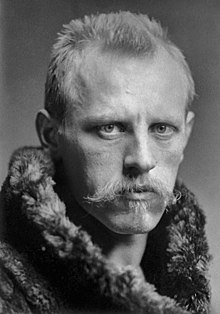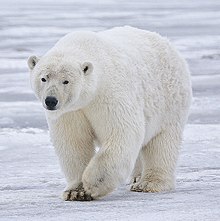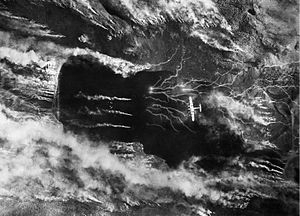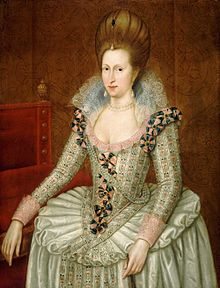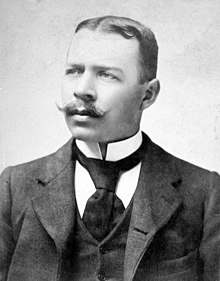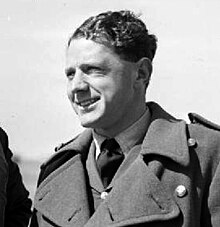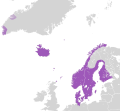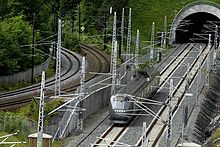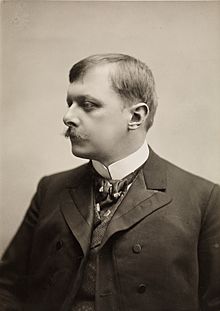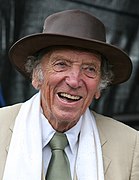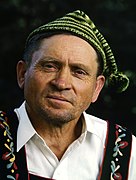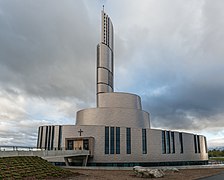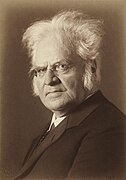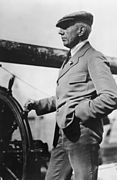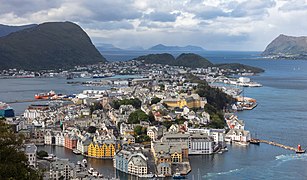Portal:Norway
The Norway Portal
Norge Portal

|

|

| |
Norway (Bokmål: Norge, Nynorsk: Noreg), officially the Kingdom of Norway, is a Nordic country in Northern Europe, situated on the Scandinavian Peninsula with a population of 5.5 million as of 2024. The remote Arctic island of Jan Mayen and the archipelago of Svalbard also form part of the Kingdom of Norway. Bouvet Island, located in the Subantarctic, is a dependency, and not a part of the Kingdom; Norway also claims the Antarctic territories of Peter I Island and Queen Maud Land. The capital and largest city in Norway is Oslo.
Norway has a total area of 385,207 square kilometres (148,729 sq mi). The country shares a long eastern border with Sweden, and is bordered by Finland and Russia to the northeast. Norway has an extensive coastline facing the Skagerrak strait, the North Atlantic Ocean, and the Barents Sea.
Harald V of the House of Glücksburg is the current King of Norway. Jonas Gahr Støre has been Prime Minister of Norway since 2021. As a unitary state with a constitutional monarchy, Norway divides state power between the parliament, the cabinet, and the supreme court, as determined by the 1814 constitution. Norway has both administrative and political subdivisions on two levels: counties and municipalities. The Sámi people have a certain amount of self-determination and influence over traditional territories through the Sámi Parliament and the Finnmark Act. Norway maintains close ties with the European Union and the United States. Norway is a founding member of the United Nations, NATO, the European Free Trade Association, the Council of Europe, the Antarctic Treaty, and the Nordic Council; a member of the European Economic Area, the WTO, and the OECD; and a part of the Schengen Area. The Norwegian dialects share mutual intelligibility with Danish and Swedish. (Full article...)
Selected article –
Selected picture –
In this month
- Thorbjørn Jagland (pictured) (born 5 November 1950) is a Norwegian politician. He was Prime Minister of Norway from 1996 to 1997 leading the cabinet Jagland, and then Minister of Foreign Affairs from 2000 to 2001 in the first cabinet Stoltenberg.
- Carsten Tank Anker (17 November 1747 — 13 March 1824) was a Norwegian businessman, civil servant and politician.
- Anne Lilia Berge Strand (born 21 November 1978 in Trondheim, Norway), better known by her stage name Annie, is a pop artist and DJ from Bergen, Norway.
- Knut Arild Hareide (born 23 November 1972 in Rubbestadneset) is a Norwegian businessperson and politician for the Christian Democratic Party.
General images –
Selected biography –
Did you know –
- ...that Norwegian resistance fighter Gregers Gram (pictured) conducted several sabotage missions together with Max Manus, before being killed in an ambuscade in 1944?
- ...that Eivind Reiten was chair of StatoilHydro, Norway's largest company, for four days?
- ...that Norwegian Socialist politician Rolf Ketil Bjørn was nicknamed "the red millionaire" due to his background in the business sector?
Selected quote –
Categories
Selected panorama
The Gathering (abbreviated as "TG" for short) is one of the largest computer parties in the world. It is held annually in Vikingskipet Olympic Arena in Hamar, Norway, and lasts for five consecutive days (starting on the Wednesday in Easter each year). (Full article...)
Main topics
Counties: • Agder • Innlandet • Møre og Romsdal • Nordland • Oslo • Rogaland • Troms og Finnmark • Trøndelag • Vestfold og Telemark • Vestland • Viken (county)
Culture: Bunad
• Constitution Day
• Cuisine
• Farm culture
• Jul
• Literature
• Music
• Cinema
History: Ancient Norwegian property laws • Nordic Stone Age • Nordic Bronze Age • Komsa • Fosna-Hensbacka culture • Funnelbeaker culture • Hamburg culture • Nøstvet and Lihult cultures • Maglemosian culture • Viking Age • Harald I of Norway • Olav IV of Norway • Haakon I of Norway • Olaf I of Norway • Olaf II of Norway • Battle of Stiklestad • Canute the Great • Magnus I of Norway • Harald III of Norway • Battle of Stamford Bridge • Magnus III of Norway • Sigurd I of Norway • Magnus V of Norway • Sverre of Norway • Haakon IV of Norway • Magnus VI of Norway • Eric II of Norway • Kalmar Union • Denmark–Norway • Union between Sweden and Norway • Dissolution of the union between Norway and Sweden in 1905 • Haakon VII of Norway • Olav V of Norway • Harald V of Norway • Occupation of Norway by Nazi Germany • Norwegian Campaign • Norwegian resistance movement • Legal purge in Norway after World War II • Foreign relations of Norway • Military of Norway • Norway and the European Union
Language: Å • Æ • Ø • Bokmål • Det Norske Akademi for Sprog og Litteratur • Differences between Norwegian Bokmål and Standard Danish • Høgnorsk • Nordic Council • Nordic Language Convention • Noregs Mållag • Norsk Ordbok • North Germanic languages • Norwegian alphabet • Norwegian dialects • Norwegian Language Council • Norwegian language conflict • Norwegian phonology • Nynorsk • Old Norse • Riksmålsforbundet • Russenorsk
Politics: Constitution • Counties (Fylker) • Elections • European Union relations • Foreign relations • Government • Monarchy • Municipalities (Kommuner) • Political parties • Prime Minister • Norwegian nationalism • Romantic nationalism • Sámi Parliament • Storting
Featured and Good content
Related portals
Northern Europe
Other countries
WikiProjects
- Parent projects
WikiProject Countries • WikiProject Europe
- Main project
- Similar projects
WikiProject Denmark • WikiProject Finland • WikiProject Iceland • WikiProject Sweden • WikiProject Russia
What are WikiProjects?
Things you can do
- Add {{Portal|Norway}} to existing See also sections of Norway-related articles.
- Tag the talk pages of Norway-related articles with the {{WikiProject Norway}} banner.
- Rate the Unassessed Norway articles in the Norway WikiProject.
- Requested articles: Requested Norway-related articles
- Expand stubs: Building and structure stubs, Company stubs, Nordic football club stubs, Geography stubs, History stubs, Musical group stubs, People stubs, All Norway stub articles
- Note: For additional tasks, see - Wikipedia talk:WikiProject Norway/to do
Associated Wikimedia
The following Wikimedia Foundation sister projects provide more on this subject:
-
Commons
Free media repository -
Wikibooks
Free textbooks and manuals -
Wikidata
Free knowledge base -
Wikinews
Free-content news -
Wikiquote
Collection of quotations -
Wikisource
Free-content library -
Wikiversity
Free learning tools -
Wikivoyage
Free travel guide -
Wiktionary
Dictionary and thesaurus



